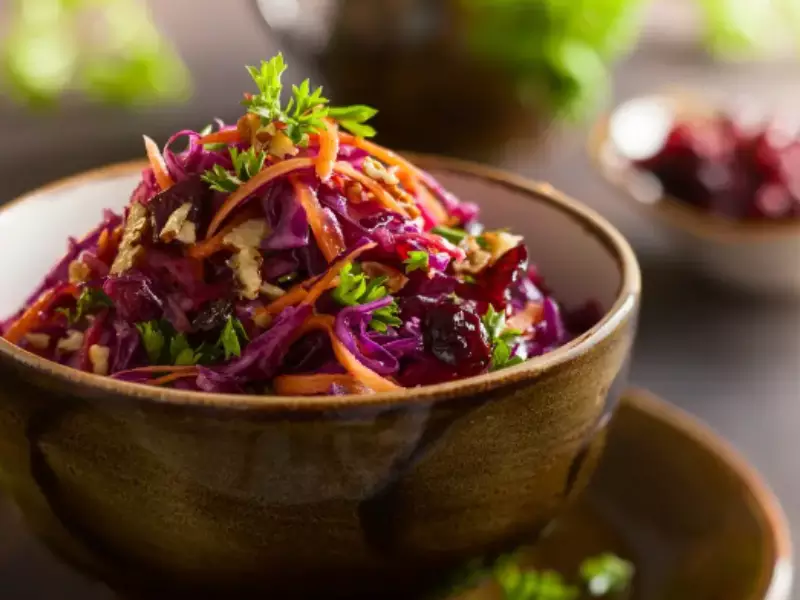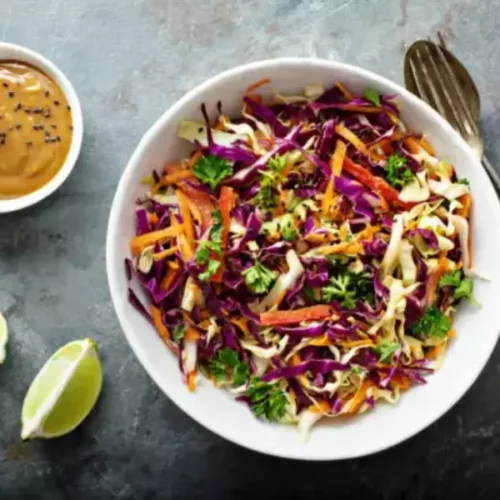Prepare yourself for a culinary journey with our delectable traditional coleslaw recipe! This meal will delight your taste buds and leave you craving more if you’re sick of tasteless salads and bland side dishes.
Enjoy our delicious Traditional Coleslaw Recipe, a cherished holiday classic that adds a burst of freshness to your festive table, and celebrate the cheerful spirit of the season. This seasonal treat takes center stage, bringing a colorful accent to your Christmas feast as the weather turns chilly and festivities warm the air.
Our Traditional Coleslaw Recipe captures the spirit of the season with its brilliant colors, crisp textures, and enticing combination of tastes, making it the ideal companion to your treasured holiday customs. Get ready to indulge in a cuisine that will not only tempt your taste senses but also make you nostalgic for happy occasions and treasured memories.

What is coleslaw?
Coleslaw is a traditional and adaptable dish that is mostly made of shredded cabbage combined with a variety of other ingredients. The word “coleslaw” is derived from the Dutch word “koolsla,” which means “cabbage salad.” Typically, finely sliced or shredded cabbage forms the basis of coleslaw, adding an enjoyable crunch.
Carrots, onions, and various seasonings are often added as additional components. There are many types of dressings that can be used in coleslaw, from tangy vinaigrette to creamy mayonnaise-based sauces. Coleslaw is typically served as a side dish that goes with a variety of dishes, including sandwiches, waffles, fried chicken, and barbecue.
Who invented coleslaw?
The exact origins of coleslaw are uncertain, as variations of cabbage-based salads have been enjoyed by different cultures throughout history. However, it is believed that the modern concept of coleslaw as we know it today can be traced back to the Dutch and English cuisines.
The Dutch, known for their love of cabbage, introduced a dish called “koolsla” in the 18th century, which consisted of finely shredded cabbage dressed in vinegar or a creamy dressing.
As Dutch settlers migrated to America, they brought their recipes with them, and coleslaw eventually became popular in the United States.

Who helped Colonel Sanders trim his menu?
Colonel Sanders received assistance from Dave Thomas, the renowned founder of Wendy’s, in streamlining his menu by reducing its size.
How long does coleslaw last?
Several elements, like the ingredients used, the method of preparation, and the way it is stored, affect the coleslaw’s shelf life. Homemade coleslaw typically keeps for 3 to 5 days in the fridge when refrigerated properly.
It’s important to remember that mayonnaise-based coleslaw dressings could have a little lower shelf life than vinegar-based dressings.
Coleslaw should be kept in an airtight container to avoid moisture loss and contamination to extend its shelf life. To prevent bacterial growth, it is best to keep it refrigerated at a temperature below 40 °F (4 °C).
It is important to throw out the coleslaw if you see any signs of spoilage, such as a sour smell, an odd texture, or discoloration, to reduce your chance of forming a foodborne illness. To guarantee coleslaw is safe and fresh, it is always advised to use your best judgment and consume it soon.

Traditional Coleslaw Recipe
Ingredients
- 6 cups chopped green cabbage
- 2 cups chopped red cabbage
- 2 medium carrots, thinly sliced
- 2 tablespoons of apple cider vinegar
- ¼ cup mayonnaise
- 1 tablespoon Dijon mustard
- ¾ teaspoon of celery seeds
- 1 teaspoon pure maple syrup
- 2 spring onions, chopped
- Salt and black pepper, to taste
Instructions
Prepare the coleslaw dressing
- In a medium bowl, whisk together mayonnaise, apple cider vinegar, Dijon mustard, maple syrup, celery seed, salt, and a few grinds of black pepper.
Make coleslaw
- In a large bowl, toss together the cabbage, carrots and spring onions. Pour the dressing over the top and toss to coat.
- Add salt and pepper to taste, stir to combined.
Serving
- Before serving, Cover and refrigerate for at least 2 hours.
Calories in Coleslaw
Servings Per Recipe: 6
Serving Size: 1 serving
Amount Per Serving
| Calories | 71.7 |
|---|---|
| Total Fat | 4.5 g |
| Saturated Fat | 0.7 g |
| Polyunsaturated Fat | 2.4 g |
| Monounsaturated Fat | 1.2 g |
| Cholesterol | 3.4 mg |
| Sodium | 299.1 mg |
| Potassium | 126.8 mg |
| Total Carbohydrate | 7.9 g |
| Dietary Fiber | 1.2 g |
| Sugars | 1.8 g |
| Protein | 0.8 g |
| Vitamin A | 21.6 % |
|---|---|
| Vitamin B-12 | 0.5 % |
| Vitamin B-6 | 2.8 % |
| Vitamin C | 20.4 % |
FAQ
What type of vinegar should I use when making homemade buttermilk?
When making homemade buttermilk, it is recommended to use regular white vinegar.
What are some tips for making homemade buttermilk?
Here are some helpful tips for making homemade buttermilk:
- Start by mixing together 1 cup of regular milk with either 1 tablespoon of vinegar or lemon juice. If you don’t have vinegar, lemon juice works just as well.
- Let the milk and vinegar or lemon juice mixture stand for approximately 5 minutes. During this time, the mixture will thicken slightly, indicating that it is ready to use.
- For best results, ensure that the milk is at room temperature before adding the vinegar or lemon juice. This step helps the buttermilk develop a thick and sour consistency.
- Instead of immediately mixing the milk and vinegar or lemon juice together, it is recommended to let it sit for up to twenty minutes. This extended time allows the mixture to fully thicken and become sour.
- Once the allotted time has passed, give the milk mixture a good stir to ensure that the vinegar or lemon juice is evenly distributed.
- Homemade buttermilk is now ready to be used in your favorite recipes. Enjoy the tangy flavor and creamy texture it adds to baked goods, dressings, and more.
By following these tips, you can easily make your own buttermilk at home, using simple ingredients and saving some money along the way.
What can I use as a substitute for vinegar when making homemade buttermilk?
When making homemade buttermilk, if you don’t have vinegar at hand, there are alternative options you can use as a substitute. One effective substitute is lemon juice. To create a substitute for vinegar, mix together 1 cup of milk and 1 tablespoon of lemon juice. Allow the mixture to sit for approximately 5 minutes. During this time, it will thicken slightly and become ready to use as a replacement for vinegar in your recipe.
How can I make my own buttermilk if I can’t find it at the store?
If you are unable to find buttermilk at the store, you can easily make your own at home with just two simple ingredients. Begin by combining 1 cup of milk with 1 tablespoon of either vinegar or lemon juice. Allow this mixture to stand for approximately 5 minutes, during which time it will start to slightly thicken. Once it has thickened a bit, your homemade buttermilk is ready to be used in your recipes. This substitution works as a great alternative if you are in need of buttermilk for cooking or baking purposes and it can be easily made using common ingredients found in most households.
What book was the recipe taken from?
The book from which the recipe was taken is called “A Treasury of Top Secret Recipes” and it is authored by Todd Wilbur.
[…] in certain circumstances, provided they are of adequate thickness and opacity. However, it’s important to choose a top that offers sufficient coverage and maintains […]